|
A crop
picture which appeared close to Winchester Science Centre on May 25,
2017 resembles the “rotating magnetic field” of an AC induction motor,
and points in the general direction of that science centre, as if to
say: “Please teach your children more about electromagnetism!”
A crop
picture which appeared near Winchester Science Centre on May 25, 2017 is
not exceptionally visually impressive, because it was drawn delicately
within a field of immature, green barley. Yet it appeared in almost the
same field location as another crop picture on June 6, 2014 which said
“NO MORE WAR” in Morse code (see
www.youtube.com). A somewhat related image, showing “squares” rather
than “circles”, appeared near Sparticles Wood on August 3, 2016 (see
Sparticleswood 2016).
This new
crop picture resembles Nicola Tesla’s patent drawing of an “AC induction
motor”
What might
this new crop picture near Gipsy Lane in 2017 be trying to tell us? It
seems to resemble the schematic representation of a “rotating magnetic
field” within an AC induction motor. That device was first patented by
Nicola Tesla in 1888:
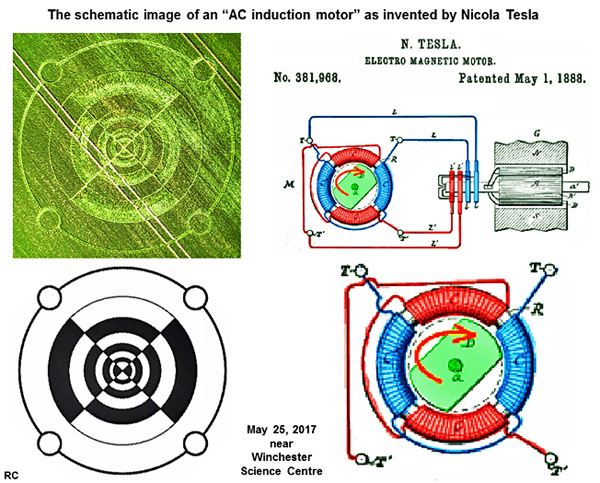
Four small
circles around the outside could be its “wire connectors” like in
Tesla’s drawing. Four big arcs of standing crop or flattened crop, along
each of seven concentric “rings”, going into or out of the centre, could
represent “four electromagnetic coils” as in Tesla’s drawing (coloured
there red or blue).
As we
proceed from one concentric “ring” to another in this crop picture,
first both “blue” (or standing crop) coils seem to be “active”, then
both “red” (or flattened crop) coils, then both “blue” (or standing
crop) coils, and so on in alternation. Tesla suggested that the magnetic
field as generated by those four coils in his device could “rotate”
around the centre, so as to drive an internal rotor.
If this
hypothesis is correct, then in order to understand more about the new
crop picture as it was drawn, we may need to explain about
“electromagnetic motors” and how they work.
How does an
ordinary DC motor work?
In the movie
below, we can see how a DC (direct current) motor works:
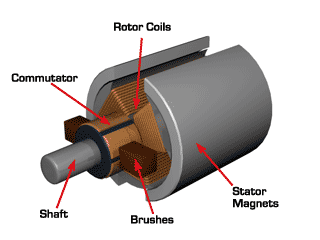
A DC motor
may include two curved, stationary or “stator” magnets outside. As a
central rotor turns in the middle, the stationary magnetic fields from
those two outer magnets will cause new electrical currents to flow
through four wire coils, which are attached to four arms of a central
“rotor”. Each of these wire coils will experience a
continuously-changing North or South magnetic field from the outer
stator magnets, because they keep changing their distance from those
magnets, as the rotor turns. This is the most basic rule of
electromagnetic current induction, known as Lenz’s Law (see
Lenz Law).
DC motors
are equipped with a “commutator” and “brushes”, because the electric
currents (so induced) by a fast relative motion between wire coils on
the rotor, and two stationary magnets along the outside, would otherwise
reverse during a 360o cycle of rotation (see
Magnetic).
Nicola Tesla
saw the technical limitations of a DC motor, so he decided to invent
something better
When Nicola
Tesla was first shown a DC motor of the late 19th century, by
his physics teacher at school, he saw that it was sparking badly, due to
the need for a “commutator” and “brushes”. These two parts cause
friction, or even wear out after lots of use! Tesla thought there had to
be a better way, and eventually invented the “AC motor” as a solution to
these problems.
We would
like to quote here from Tesla’s autobiography, Part III, “Discovery of a
Rotating Magnetic Field” (see
inventions):
“It was in
the second year of my studies that we received a Gramme dynamo from
Paris, having the horseshoe form of a laminated field magnet, and a
wire-wound armature with a commutator. It was connected up, and various
effects of the currents were shown. While Professor Poeschl was making
demonstrations, running the machine as a motor, the brushes gave
trouble, sparking badly, and I observed that it might be possible
to operate a motor without these appliances? But he declared that it
could not be done, and did me the honour of delivering a lecture on the
subject, at the conclusion of which he remarked: ‘Mr. Tesla may
accomplish great things, but he certainly never will do this. It
would be equivalent to converting a steadily pulling force, like that of
gravity, into a rotary effort. It is a perpetual motion scheme, an
impossible idea.’ But instinct is something which transcends knowledge.”
How does an
AC induction motor work?
Now let us
see how an AC induction motor works, as invented by Nicola Tesla in
1888. It does not use “brushes” or a “commutator ”. Tesla’s first “AC
induction motor” included four long coils around the outside, which are
changeable electromagnets rather than permanent magnets. An alternating
AC power supply is then wired up, so that it activates in succession
first two “blue” coils”, then two “red” coils, then two “blue” coils,
and so on in an alternating fashion:
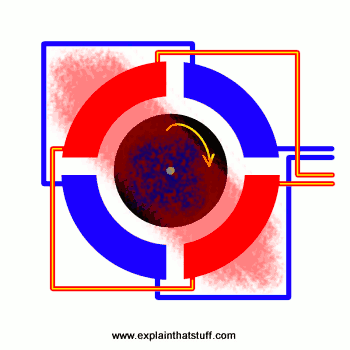
An internal
rotor from this device turns in response to those ever-changing or
“rotating” magnetic fields, because of repulsive magnetic forces induced
according to Lenz’s Law (see
www.youtube.com). The interested reader can learn more here
(see
induction-motors):
“For
an AC motor, there is a ring of electromagnets arranged around the
outside, which produce a rotating magnetic
field. Inside there will be some freely-rotating part that can conduct
electricity. Unlike for a DC motor, where you send power to an inner
rotor, for an AC motor you send power to its outer coils. Those coils
are then energized in pairs, and in temporal sequence, so as to produce
a magnetic field which rotates around the outside.
This rotating magnetic field causes an internal rotor to spin in the
same direction at almost the same speed.”
The image of
a “rotating magnetic field” from that AC induction motor seems similar
to what was drawn in crops
Near
Winchester Science Centre on May 25, 2017, we saw what might be the
schematic diagram of an “AC induction motor”, drawn delicately in young
barley. This crop picture shows four small circles around the outside
(which could be “wire connectors”), along with seven concentric “rings”
on the inside, each of which has been divided into four sections or
“long coils” of standing crop, then flattened crop, then standing crop,
and finally flattened crop again:
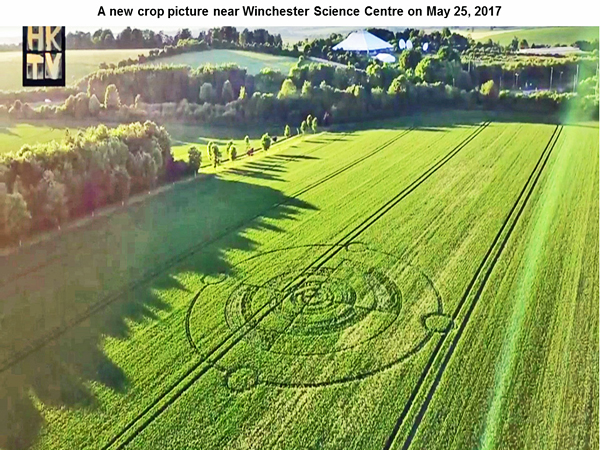
As we
proceed from its outermost “large ring” to its innermost “small ring”,
each circular section of “four coils” switches or alternates between
standing crop and flattened crop, almost as if in “temporal sequence”.
The detailed images which we can see there, drawn in crops, look like
other images shown in the explanatory movie for an “AC induction motor”.
Why would
the crop artists show us such a thing? Well, what could be more
important to our modern society than the concept of a “rotating magnetic
field”, as first developed by Nicola Tesla in 1888? Without it, we would
still be living in a primitive fashion indeed, with no universal
electrical system, no airplanes, no computers or anything else which
most of us take for granted today.
Another crop
picture was drawn in almost the same field location near Winchester
Science Centre, three years earlier in 2014
Interestingly enough, there was another crop picture drawn near
Winchester Science Centre in almost the same field location on June 6,
2014. That crop picture showed an Archimedean spiral of four turns,
along with a coded message in Morse code of “NO MORE WAR”:
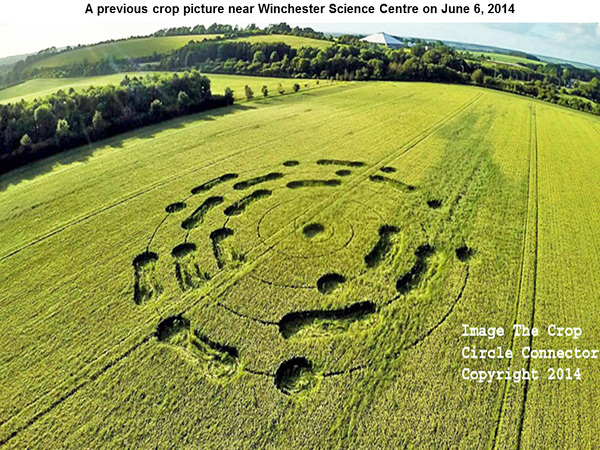
The
appearance of this crop picture coincided with remembrance ceremonies
for the “D-Day invasion of Europe”, 70 years earlier on June 6, 1944.
Combining
the two field images drawn near Winchester Science Centre in 2014 or
2017
Perhaps
those crop artists are asking us to combine the images from both crop
pictures in 2014 or 2017, in order to find a more complete message? When
we construct a new diagram which combines both the crop picture drawn on
May 25, 2017, and another crop picture drawn in almost the same field
location on June 6, 2014, we can see the suggestion of pulsed, clockwise
rotation for our “AC motor”:
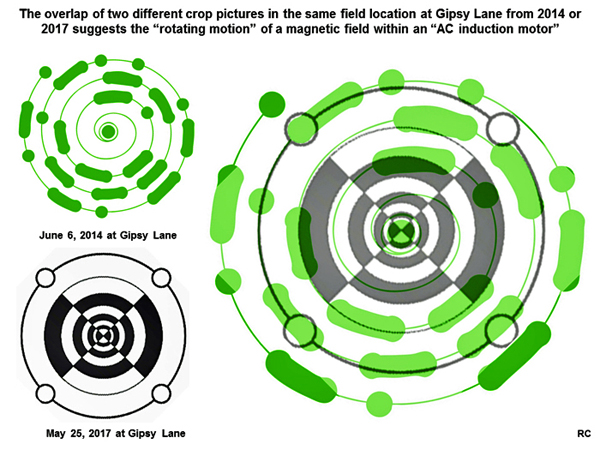
The process
of switching in Morse code between “dots” and “dashes” (short or long
electrical pulses) seems similar to the process of switching between
“red” and “blue” electromagnetic coils for an AC induction motor. Their
2014 crop picture showed 22 dots or dashes in total, while their 2017
crop picture shows 7 x 4 = 28 curved arcs or “coils”.
Several
other crop pictures in 2017, for example at Waden Hill on April 22,
Oliver’s Castle on April 24, or Willoughby Hedge on May 4, only revealed
a definite symbolic meaning, once combined with nearby (or overlapping)
crop pictures from previous years.
Where was
this 2017 crop picture drawn relative to important landscape features
nearby?
A “long thin
line” within the new crop picture does not point toward Winchester
Science Centre itself, but rather towards a Holiday Inn on the right,
where families may stay if they wish to visit the Science Centre with
their children:
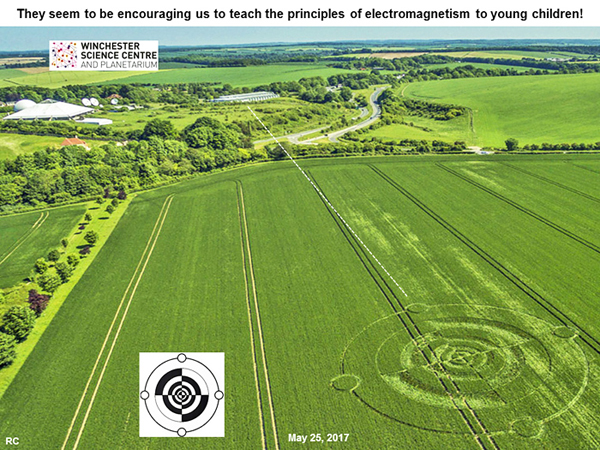
There will
be an educational exhibit called “High Voltage” available there from May
26 to June 5, 2017 (see
summer-half-term-high-voltage).
When we
study the landscape near this crop picture on a broader scale using
Google Earth (at latitude 51.056o N, longitude 1.265o
W), we can see that it was drawn close to a thick line of trees which
looks like a “bar magnet” as viewed from above. That “bar magnet” in the
landscape points towards the Science Centre along its long axis (see
Space science centre videos).
One of the
buildings at that Science Centre, close to where the crop picture
points, looks like a “bar magnet inside of a wire coil” when viewed from
above (at latitude 51.060o N, longitude 1.264o W).
Just above
that “bar magnet” in the landscape, we can see a large “T” shape made
from two crossing rows of trees (at latitude 51.053o N,
longitude 1.267o W, South facing “up”). It would be pleasant
to think that this large “T” shape might suggest the name of Nicola
“Tesla”, in the context of what was just drawn.
Red Collie
(Dr. Horace R. Drew)
P.S. Many
thanks to Matthew Williams or Hugh Newman for excellent aerial drone
photographs of the new crop picture near Winchester Science Centre (see
www.youtube.com or
www.youtube.com) and Marvin Naylor for a ground video (see
www.youtube.com). |